Left in blood: The Cathy Swartz murder
This report contains graphic crime scene photos and details. Viewer discretion is advised.
THREE RIVERS, Mich. (WOOD) — The killer of 19-year-old Cathy Swartz left behind more than just his victim’s baby, unharmed, in the room down the hall.
There was also a fingerprint and a footprint, both left in blood.
And, what of the cryptic message left on Cathy’s leg?
From the start, detectives were certain that they had all they needed to quickly solve the brutal murder.
But along the way, some of their evidence was lost. Opportunities were missed. An innocent man was left to live under suspicion for nearly 35 years.
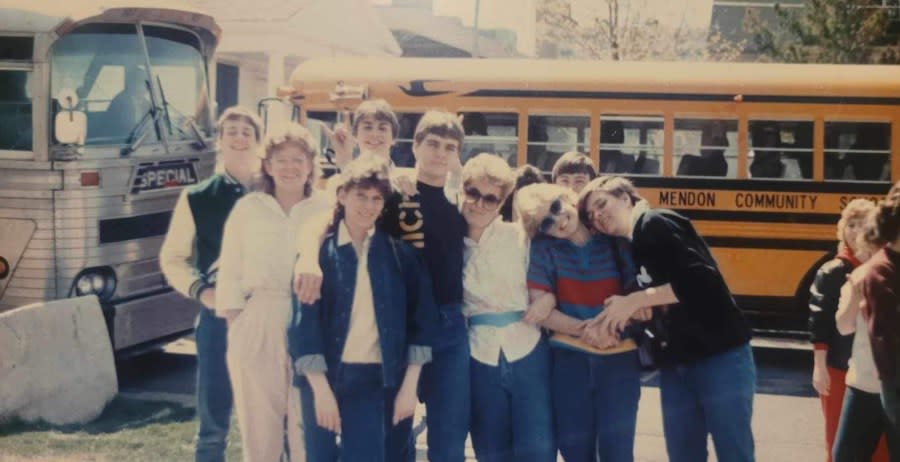
PART 1: THE CRIME SCENE
Cathy Swartz, her baby, Courteney, and her fiancé shared a small, two-story apartment at Riverside Townhouses, a gathering of tidy brick and aluminum-sided rentals on the edge of Three Rivers.
A fully decorated Christmas tree stood in a corner of apartment 102, partially blocking the back door.

It was just three weeks before baby Courteney’s first Christmas, and, for her, it would be a Muppets Christmas.
The stuffed Kermit, Miss Piggy and Fozzy Bear were already under the tree, along with a “Baby Kermit’s Christmas” book.
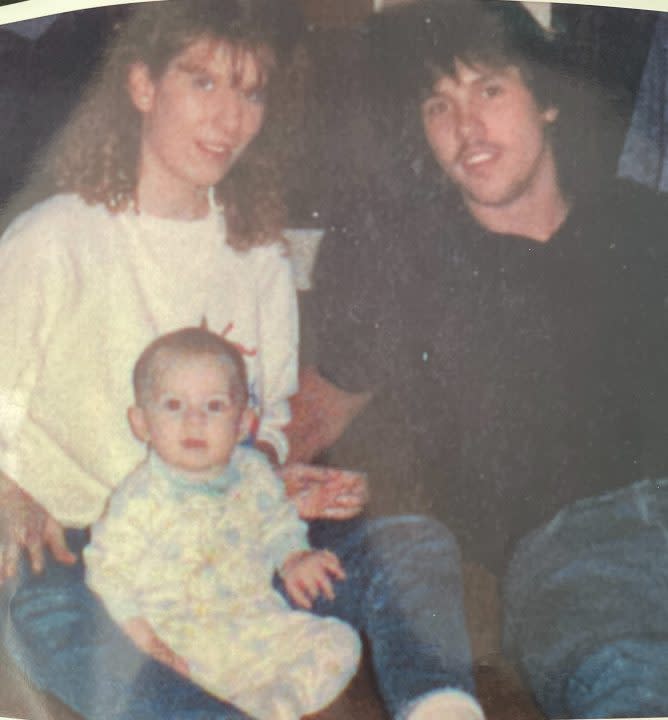
Mike Warner, the man Swartz planned to marry, told police he came home from work mid-afternoon, as always, on Dec. 2, 1988, expecting to find her watching her favorite soap opera, “Guiding Light.”
“It was smeared all over,” he said of the blood. “Walls, everywhere. I mean it was like painted on. That bad, yeah.”
His fiancé was dead in an upstairs bedroom.
Swartz’s daughter, Courteney, the child he had planned to help raise, was standing in her crib, unharmed, in another room. Barely old enough to stand on her own.
It appeared the baby’s diaper had been recently changed.
Thirty-five years later, Courteney’s memory of her mom, what she looked like, is a photograph of her sitting on her mom’s lap.
“That’s all I have,” she told Target 8. “I just wish I could have got to meet her, or like know her, you know. It hurts.”
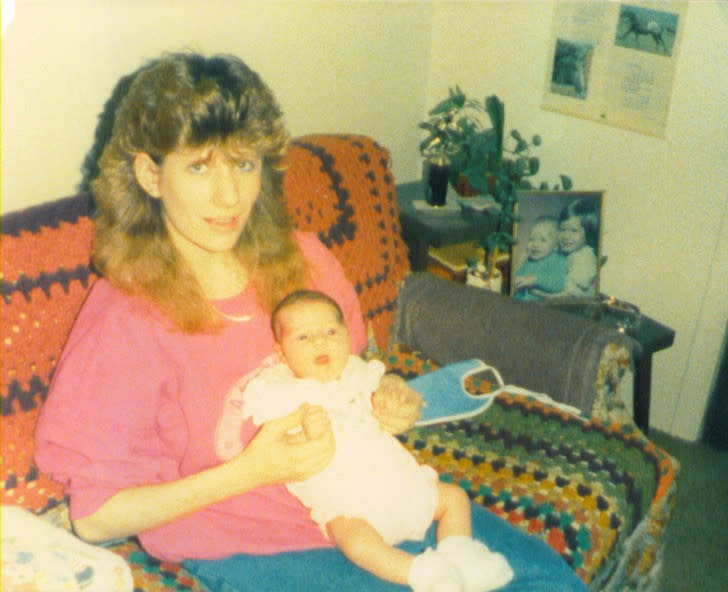
Courteney is now 35, and a mother herself. What she knows about her mom and her murder is from her mom’s parents, who raised her, and later, from police reports.
“I remember my whole life just going to the store or anywhere, seeing people, and just wondering, ‘I wonder if that’s who killed my mom?'” she said.
Of all the police officers who responded to her mom’s apartment that day, the team that included veteran Michigan State Police Crime Scene Technician Ken Laninga had the most important job: Find and preserve evidence that could lead them to the killer of Courteney’s mom, and, ultimately, to a conviction.
“It was probably bloodier than most scenes, other than, I mean where the blood was found,” Laninga told Target 8 in a recent interview. “I mean it was smeared up the railing and against the wall going upstairs.”
“That’s the thing that struck you. It appeared as though she was fighting for her life. She was trying to survive. Unfortunately, that was not the case,” he said. “I had small children at the time, not that young. Thinking of that poor little baby in that crib, hearing what’s going on and I’m sure her mother is screaming.”
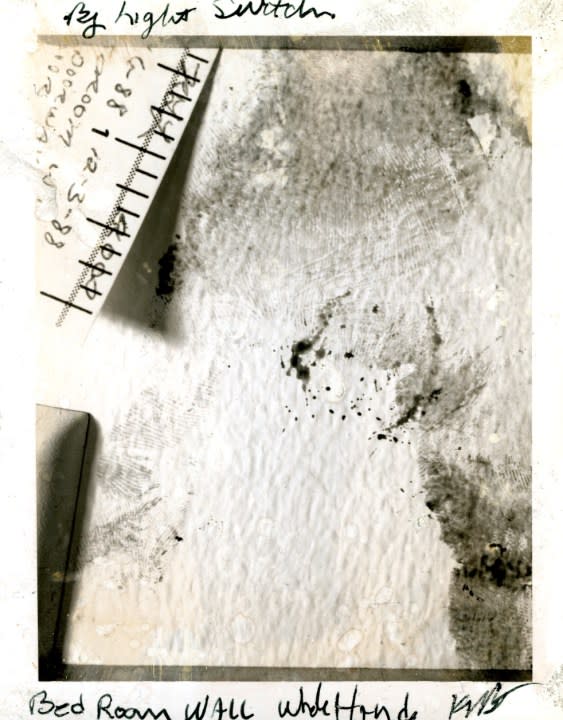
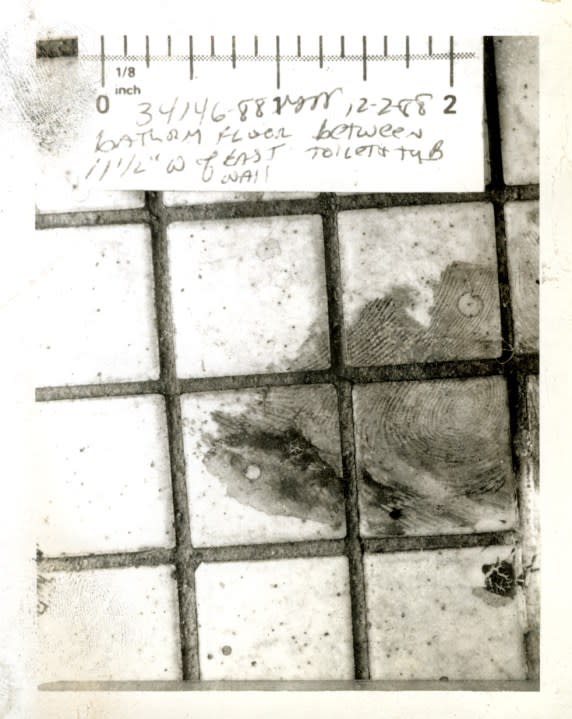
Cathy Swartz had been beaten and strangled before her throat was cut, left to die in her bedroom.
From the start, then-Prosecutor Jeffrey Middleton worked closely with police on the investigation. It became the most time-consuming case of his career.
“A young woman is killed in her apartment, and her 9-month-old baby’s in a playpen, and it’s in your town, and everybody knows about it, and people are frightened about it, and she deserved better than that. She deserved to have it solved,” Middleton said in an interview with Target 8.
On the pink phone in her bedroom, crime scene technicians found a bloody fingerprint. The phone line had been cut.
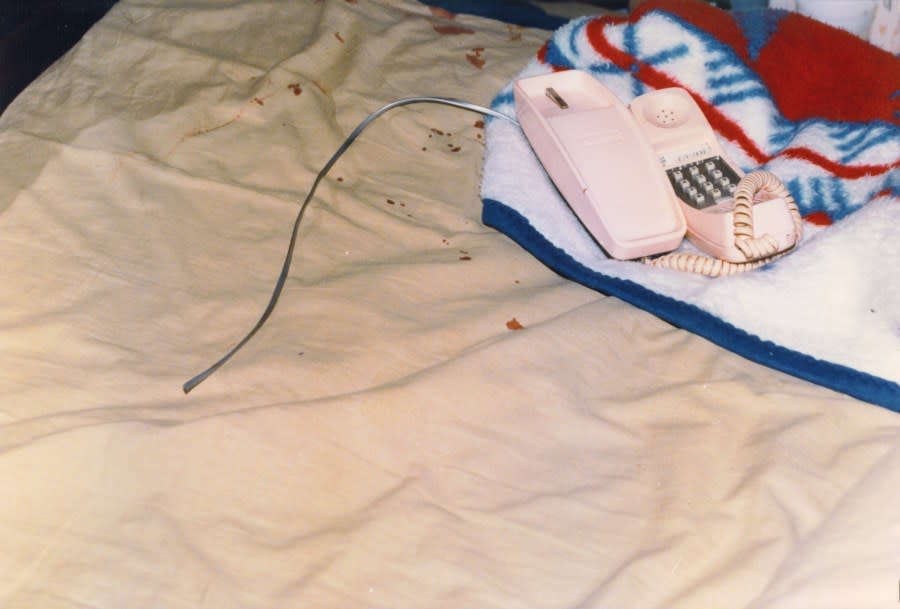
“Besides the bloody fingerprint on the phone, which was in the room where she was found, there was a blood-kind of water mixture footprint on the bathroom floor,” Laninga said. “It appeared as though the suspect had washed up or taken a shower afterward to clean up.”
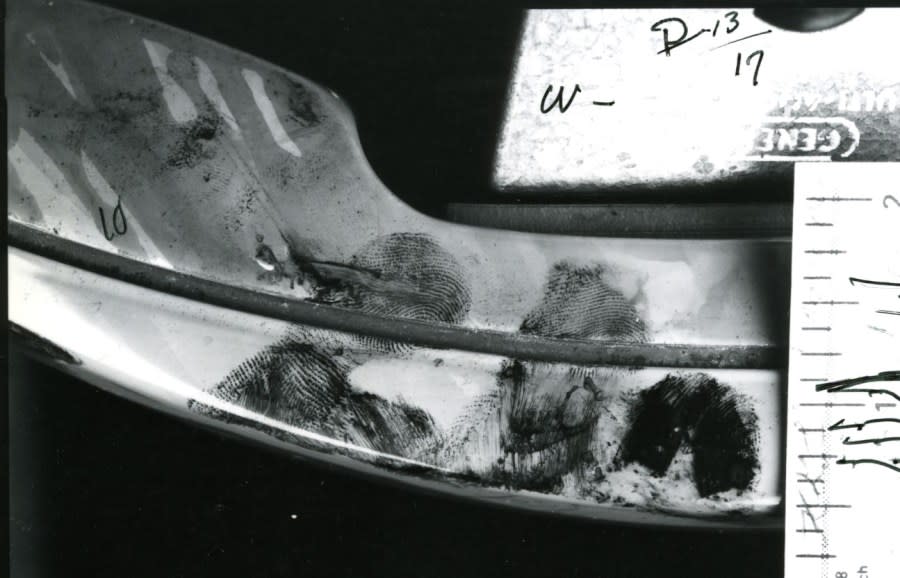
The bath water was still running when crime scene investigators recorded the scene on video hours later.
The killer left behind a size 9 left bare footprint in blood.
Like fingers, the toes and the balls of the feet have distinct prints.
“Having a footprint, not a shoe print, but a footprint, bare footprint in blood was unusual,” Laninga said. “As a matter of fact, I think that’s the only case that I ever was comparing footprints against in my career there.”
The crime scene quickly went from grizzly to bizarre.
The state police techs had been training with a new piece of equipment: a hand-held wand that, used with powders that fluoresce and special goggles, illuminate evidence not visible to the naked eye.
This was their first time using it. To make it work, they turned off all the lights.
Out of the darkness, messages glowed an eerie green on the refrigerator door.
“When we hit it with that alternate light source, it said ‘Metallica’ and the name ‘Harley’ on the refrigerator,” Laninga said.
Specifically, “Harley was here.”
They moved the light over Swartz’s body.
“In examining her body looking for hairs and fibers, we found writing on the inside of her thigh,” Laninga said. “And it said, ‘I was here.'”
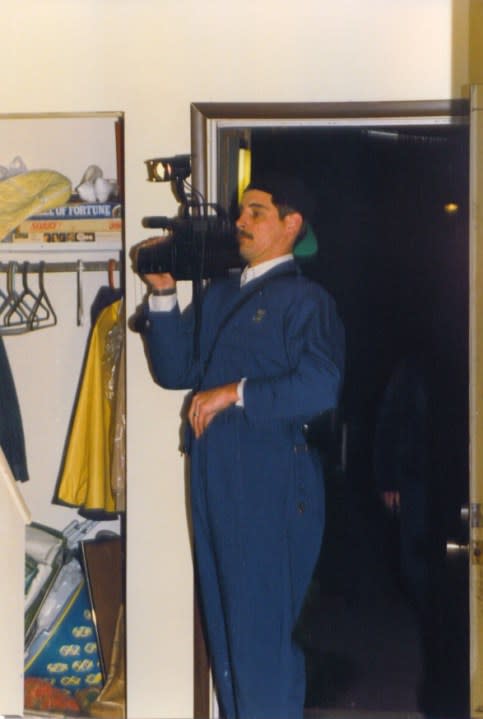
“It kind of blew our minds. I mean we’d never seen anything like that before,” he said.
Police were certain: The killer must have left that.
“That was my initial thought, and I think most people’s initial thought, that the killer wrote on her leg,” Laninga said.
But, why, police wondered, was the writing not plainly visible? Was it some kind of disappearing ink?
“I have no idea what it was written with,” Laninga said.
The police chief at the time, James Rifenberg, said they found no signs that anything was missing. Friends say Swartz always locked her doors.
This, police said, appeared to be a sexual assault; or at least an attempt.
“There was no evidence that anybody broke in either,” Rifenberg said. “There was a lot of mystery right from the very start.”
A neighbor told police they came home the same day to find somebody had tried breaking into their apartment. Police found pry marks on their door jamb.
But detectives believed it was a coverup, an attempt to make it look like this was the work of a stranger bent on burglary.
“I knew that whoever had done it, she knew,” Swartz’s long-time friend, Jennifer Outman, told Target 8. “There was no doubt in my mind because she would not let anybody in her apartment unless she knew them. I would call her and I would say, ‘I’m coming over,’ and it took all of five minutes to drive out there, and I would still have to knock because the door was locked, both doors, and she would look and make sure then let me in. So I knew, I knew it was somebody that she knew.”
“Maybe they sat there and talked because he probably didn’t come in like a wild-eyed killer,” Middleton, the former prosecutor, theorized. “He came in and said, ‘Hey, how ya doing? Can I come in?’ And then, it went south from there, like he was there with the intent to have relationship with her and she wasn’t interested and that’s when it turned into a homicide.”
Cathy Swartz had no known enemies.
She grew up on a two-acre farm in nearby Mendon, a tiny village wedged between corn fields on a bend of the St. Joseph River. She was in Girl Scouts, 4-H and had a pony when she was 8.
Her class of 1987 at Mendon High School was so small that it barely filled two pages of the yearbook.
“We went to school together, forever,” her friend Outman said.
Swartz’s family moved to Three Rivers before her senior year. Her dad ran the pro shop at the local bowling alley, where Swartz bowled in a league with her mom. She worked for a time at the local Burger King.
In March 1988, at age 18, after dropping out of high school, Swartz gave birth to Courteney.
“We were pregnant together and both single moms, and we just kind of meshed together and started hanging out and talking,” Outman recalled. “I’d go over and hang out with her and Courteney at the apartment, bring my daughter.”
“She was a great mom. She was strong, she was confident in her ability to be a mom. She was just a wonderful person all around,” Outman said. “Courteney was her pride and joy. She was everything to her, and she took very good care of her, loved her very much.”
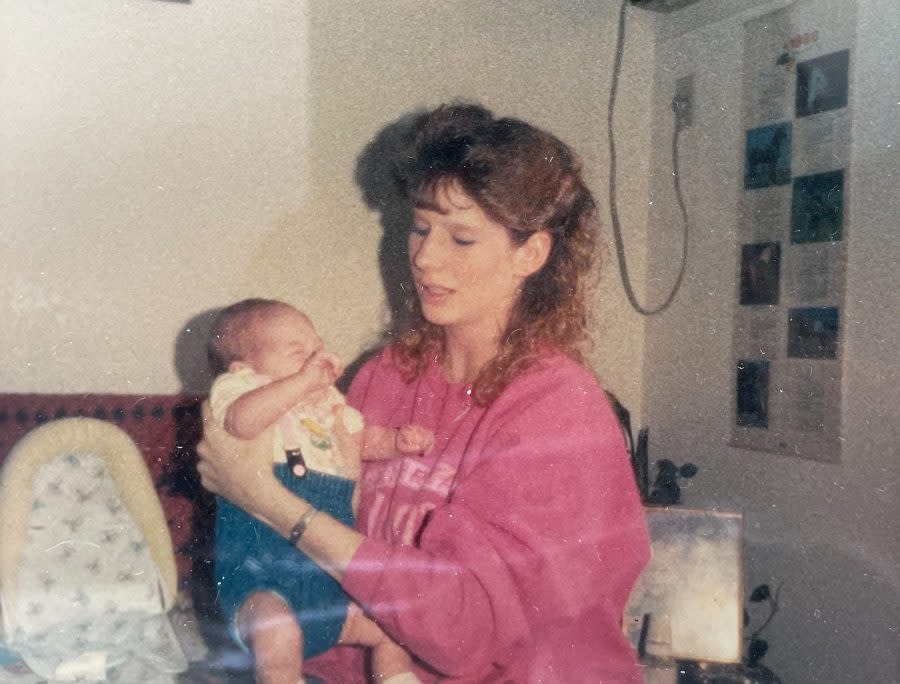
And, she said, Swartz loved her fiancé, Mike Warner.
Courteney was just 6-months-old when Swartz and Warner met in September 1988. They got engaged on Nov. 10, three weeks before the murder. He worked at a paper plant.
“He was the sweetest person,” Outman said. “You could tell that he truly loved her, and she was definitely in love with him, and they were very happy together.”
He came home often with flowers. Swartz left him love notes.
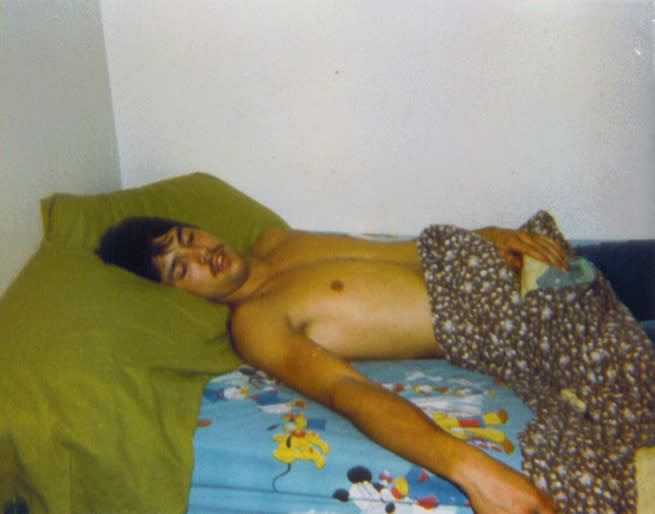
Warner told Target 8 he loved “everything” about Swartz.
“We just had fun together, all the time,” he said.
The night before the murder, Cathy and her fiancé ate fish and chips, played a couple of board games — Sorry and Pay Day — before turning in at midnight. Bedtime was briefly interrupted by four friends banging on the door at 12:30 a.m. Her fiancé told police he opened the upstairs bedroom window and told them to leave.
Swartz kissed him goodbye, he told police, still in her nightshirt, when he left for work at 5:25 the next morning.
The fiancé told police he worked all day, came home at 3:30 in the afternoon and used his key to open the front door, though he wasn’t sure it was really locked.
He told police he didn’t think much of the drops of blood in the foyer. Maybe, he thought, Cathy had cut herself. Then more blood, smeared on the walls going up the stairs. Once upstairs, he looked one way and saw Courteney standing in her crib in the baby’s bedroom, not making a sound.

He looked the other way and saw Cathy in their bedroom, in the doorway, blood covering her face and nightshirt, which was pulled almost completely off. He screamed her name, then ran to a neighbor, who called the police. He ran back inside to get Courteney.
One police report suggested that the killer had changed the station on her radio to easy listening, which was not Cathy’s usual music.
Three Rivers Police Detective Kenny Baker was among the first on the scene.
He would later tell cold case detectives that he believed somebody had moved her body, “turned it around 180 degrees, pulled it out to the doorway so she could look at the baby in the baby crib.”
The autopsy revealed three separate cuts on her neck, one that was 2 and an eighth inches deep and hit both the right common carotid artery, which supplies blood to the brain, and the right internal jugular vein, which sends blood from the head to the heart.
It found evidence that the killer had strangled her by hand, along with multiple abrasions and bruises to her neck, trunk and extremities. And, there were cuts on her hands, defensive wounds. The listed cause of death was the deep cut to her neck and strangulation.
While police didn’t find a murder weapon, they did find what appeared to be the outline of a pair of scissors, in blood, on a pair of sweatpants.
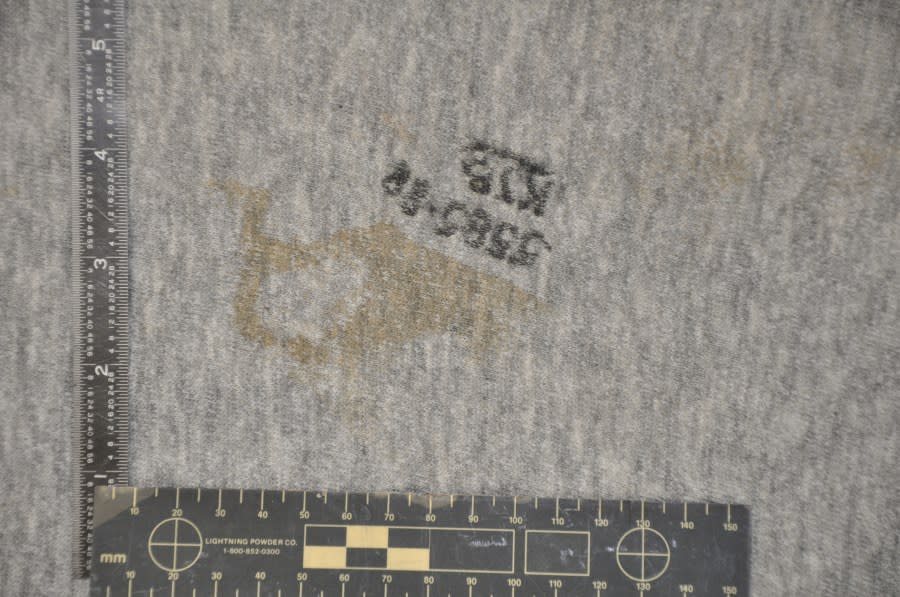
Her friend, Jennifer Outman, had no doubt she put up a fight.
“She was tough, she was a survivor, I completely believe that,” Outman said. “That doesn’t surprise me at all that she fought like that. I’d have done the same thing if my daughter was in the apartment, especially.”

It appeared the killer, after showering, escaped past the fully decorated Christmas tree, over the stuffed Muppets, and out the back door, knocking down a candy cane along the way.
Neighbors saw nothing that could help. There had to be screams, but nobody reported hearing them, even with walls thin enough to hear the neighbor’s TV.
“If he’s killing my mom, it’s noisy,” Courteney said. “I’m not screaming? I’m not crying? Nobody hears me? Nobody hears the ruckus that’s going on in the apartment?”
The medical examiner told police that the beating likely lasted 15 minutes for the bruises to turn the color they did.
They figured she died shortly after noon.
As for baby Courteney, she was clean and no longer in her PJs, instead wearing pants, a shirt and one Cabbage Patch sock. Her disposable diaper was only damp.
Perhaps, police surmised, the killer had taken care of the baby.
“We wondered, the thought maybe her diaper had been changed,” said Middleton, the former prosecutor.
Later that day, Swartz’s best friend was home with her own daughter when Three Rivers police picked her up and drove her to the station.
“I kept asking, ‘Is this about Cathy?’ Because that day, I knew something was wrong. I knew in my heart, I knew something was wrong because we talked every day multiple times a day on the phone, and I kept calling and calling and there was no answer, and I just knew something was not right,” she said. “I was terrified. Terrified of how that could happen, and who it could have been, and do I know them?
“I slept with a machete under my mattress for years. That kind of thing doesn’t go away,” she said. “This is a small town. It was huge because we’re just a small town, nothing bad like that happened before.”
PART 2: THE SUSPECTS
Police, not surprisingly, took a long, hard look at Cathy’s fiancé, Mike Warner.

“He was real hard to get a handle on,” said Middleton, the former prosecutor. “He just lost his girlfriend, his apartment was in disarray, and very little affect. It was like, ‘Yeah, that’s too bad.'”
But his alibi was solid.
“I was at work that day,” Warner said in a recent interview.
He worked about a half-hour away at Lakeland Paper in Sturgis.
And his prints didn’t match.
“They were on me every day,” Warner told Target 8. “They thought I knew who did it. I didn’t, you know? They kept pressuring me, ‘Tell us who did that?’ You know?”
Swartz’s best friend never suspected the fiancé.
“She was in love with him,” Outman said. “He was so good to her. He was kind to her, he accepted Courteney. She was madly in love with him.”
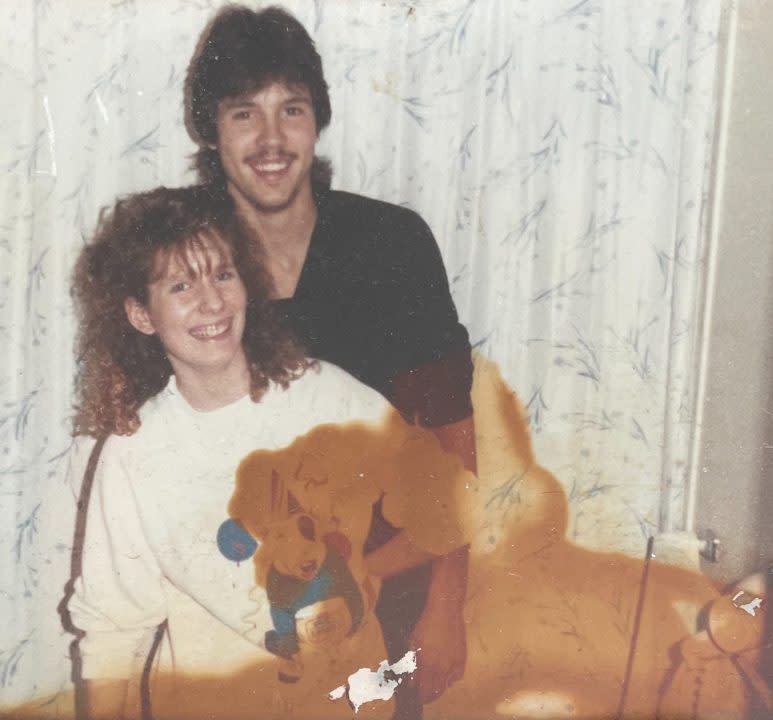
Even with the fiancé all but eliminated as a suspect, police remained confident.
The killer had left his calling card: a fingerprint left in blood and a bloody footprint.
And, police had those hand-written messages: “I was here” on Cathy’s leg, and “Metallica” and “Harley Was Here” on the refrigerator.
Swartz’s ex-boyfriend, 19-year-old Troy Schulthies, was a huge fan of Metallica. All his friends knew that. And, he loved Harley Davidson motorcycles so much that it earned him a nickname: Harley. He had a Harley sticker on the back window of his Ford Ranger.
“He was my first thought,” Swartz’s friend said.

There were reports, court records show, of a rocky relationship. Even Troy Schulthies’s mom had heard that.
“They said he was mean to her and all that,” his mom, Pearl Schulthies, told Target 8. “I mean that’s somebody’s word against his. I don’t have any idea whether that’s true or not.”
Swartz’s fiancé, who considered Schulthies as one of his best friends, told police that Harley had called him from a high school dance hours after the murder, checking to see if Swartz was OK.
“He asked me if Cathy was alright,” the fiancé told police. “I told him ‘yeah,’ and he asked me if I was sure because there was some rumor going around that she got shoved back into her apartment.”
Schulthies asked Warner to go check on her.
It didn’t help that Schulthies had no alibi.
“There was a witness who saw his truck there that very afternoon, at the end of the school day,” the former prosecutor said.
His arrest three days after the murder made headlines.
Schulthies, who had no criminal past, denied the killing.
The refrigerator calligraphy? He had drawn it with a red marker months earlier at a party, he told the original detectives, and had wiped it off, which would explain why it wasn’t visible to the naked eye.
“The same time he wrote on the refrigerator, Metallica and all that stuff, is when he said he wrote on her leg,” Detective Baker later told cold case detectives.
Detectives sent Schulthies’ fingerprints and footprints to the state police crime lab in Grand Rapids, still confident they had their killer.
“Initially, this Harley individual looked like a pretty good suspect, and I don’t know what other things led the detectives to feel that way, from the writing, his name, everything fluorescing the same and looking like it was written and thinking at the time it may have been written by the killer,” said Laninga, the retired crime scene technician. “Harley was arrested and they got his fingerprints and footprints, and I think they hand-delivered them to me as soon as they got them. They want me to compare them.
“I’m looking at the prints and it’s not him,” Laninga said. “I can’t identify the prints to him. They’re not him. That was not the phone call you wanted to make and call back to them and say, ‘This isn’t your guy.'”
Police released Schulthies from jail nine days after his arrest, with little explanation.
But the suspicion followed him for years.
Everyone in town thought he was the killer, his mom, Pearl Schulthies, said.
“Oh, no doubt, no doubt at all,” she told Target 8. “In fact, he quit his senior year in high school. He quit because of that.”
Undeterred, detectives worked down their list of possible suspects, including another man from Swartz’s past, Michael Howard, a person of interest with a possible motive.
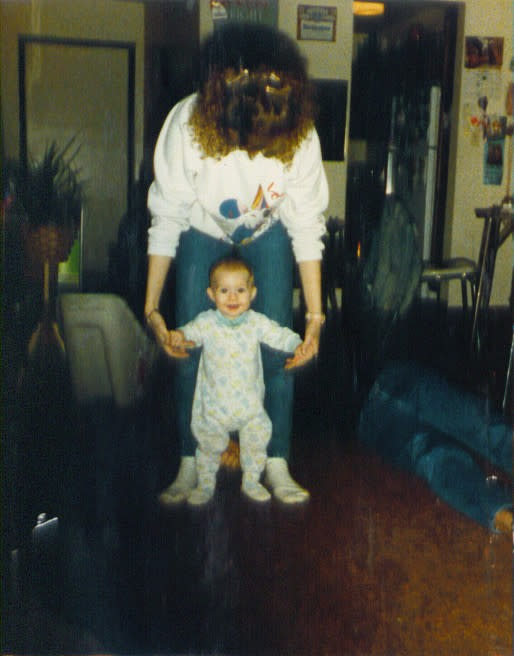
In a paternity suit filed by the state, Swartz insisted Howard was Courteney’s father.
“I mean, you hear about that all the time,” Cathy’s friend said. “You hear about, ‘The guy doesn’t want to be a dad.’ Maybe, it was a maybe.”
Four days after the death, a court-ordered paternity test came back: Positive. Michael Howard was the dad.
Middleton, the former prosecutor, said police looked closely at the new dad.
“Same thing,” Middleton said. “It wasn’t his fingerprint, wasn’t his footprint, and couldn’t get a real handle on him. But yeah, he was one of the early suspects.”
The baby daddy had a solid alibi: He had been working all day, before spending time with his new girlfriend and his mom.
Swartz’s fiancé said he also gave detectives the name of an old elementary school buddy, Robert Waters, who had visited their apartment a month before the murder.
“I ran into him at the grocery store, I believe,” the fiancé recalled. “Invited him over; he came over one night.”
But Waters, who was 19 at the time, had moved to Arizona before the murder. Another name crossed off the list.
Then, there was this bizarre turn: On the same day of the murder, and at nearly the exact time, a car speeding out of Three Rivers plunged into the St. Joseph River.
It took a half hour for rescuers to pull 24-year-old Christina Shelton and her 3-year-old daughter from the submerged car.
The child survived.
The next day, the murder and fatal crash shared the front page of the Three Rivers Commercial-News.

What the initial stories didn’t say: The deceased driver and Cathy Swartz were neighbors.
“Same apartment complex,” the former prosecutor said.
“She left the apartment for reasons unknown and was headed toward Centreville and she had her daughter in the car,” Middleton said. “She was driving along the river and she went in the river and drowned, and they saved the daughter.”
A witness told police Shelton was speeding and had crossed the centerline before veering headlights-first into the cold water. The road was dry.
“The speculation always was that she saw something that was upsetting to her and she took off to come get away, or come to Centreville,” Middleton said. “So we never were able to determine whether those two cases were connected.”
Police compared footprints and fingerprints on the woman’s birth certificate against those left by the killer.
“She wasn’t the killer,” Middleton said.
“She’s got her family still here,” he said. “They’re nice people and they had a loss that day that’s never really been understood, and I don’t know to this day if those two things are connected or not.”
Police also released a composite of a woman spotted in the area who they believed was either the suspect or an accomplice. It generated no leads.
With the obvious suspects all but eliminated, detectives grew desperate.
Every day for six months, the lead detective in the case staked out the cemetery where Cathy is buried, hoping the killer would pay her a visit.
Occasionally, Detective Baker found a single rose atop the tombstone.
“On the anniversary of her killing, the one-year anniversary, we videotaped three days before and three days after, from a trailer back over off of the gravesite, and that’s where we found this guy,” Baker later told cold case detectives. “He had a friendship ring that he had gotten from Cathy in elementary school or middle school. After she was buried, he went out and dug a little spot and buried the ring. It was a friendship ring, and we got him on videotape.”
The detective described the man as shy, bashful and a bit withdrawn.
Another side-by-side comparison of prints; Another suspect eliminated.
Within three years of the killing, police had fingerprinted and taken footprints of more than 1,000 people and said they had 3,000 to go.
The footprint was like Cinderella’s glass slipper, with police looking for an exact fit.
“The detectives at Three Rivers PD probably got to be some of the best footprint takers of anybody around, because they had to do it a lot,” said Laninga, the retired crime scene technician.
Detective Baker considered everyone: high school classmates, dropouts, friends, relatives, known sex offenders, former Burger King co-workers, people she knew at the bowling alley. Dead people.
“Let me talk about dead people,” Baker later told the cold case detectives. “Four or five, six people died, and we went and got footprints from their corpses at the funeral homes, and they were eliminated.”
“Everyone cooperated because they didn’t do it,” said Middleton, the former prosecutor. “And the best way to get the police off your back was to give them your footprint and your fingerprint.
“We thought the first time someone says no, we’re going to focus the light on them and see what we need to do, but no one said no,” Middleton said.
They printed Swartz’s best friend.
“They told me, they said, ‘You know, we do not suspect you, this is for process of elimination’ because I’d been there, I’d been in the apartment before,” Outman said.
They eliminated seemingly everyone, including those four friends who stopped by the apartment the night before, even convicted child killer Daniel Furlong, rightfully considered the creepiest man in St. Joseph County.
Furlong is in prison for sexually assaulting and suffocating 11-year-old Jodi Parrack in 2007 in Constantine, the first town south of Three Rivers. He tried doing the same to another girl a few years later but she escaped, leading to his arrest.
“My grandpa thought it was a cop, like it was a cover-up,” Swartz’s daughter, Courteney, said.
The former prosecutor said he’d heard the same rumors.
“All the time,” he said. “In fact, people will still say it.”
But every Three Rivers officer was printed, the former prosecutor said, and all were eliminated.
“We had this great forensic evidence and we’re going to solve this by the first of the year, and then we made an arrest and it isn’t the right guy and then, we’re going to solve it by the end of the year, then we’re going to solve it within two years, then it’s five years, then it’s 10 years,” Middleton said.
The prosecutor even offered a get-out-of-jail-free card.
“If your client is charged with drunk driving or retail fraud or auto theft or something and you can tell me who matches that fingerprint, I will give you a free pass on your drunk driving charge,” he said. “Probably shouldn’t do that, but it was understood.”
An FBI criminal profiler described the kind of killer they might be looking for: A male aged 15 to 25 with the mentality of a 15-year-old; someone who lived nearby, connected but not closely to Cathy’s circle of friends, possibly a window peeker, probably a loner, someone not good with women.
“To people who know him,” they wrote, “he may be the last person on earth they would suspect.”
The killer likely was remorseful, with a fear of what might happen if he’s caught.
“He is also likely to blame her for the death because all he wanted was sex from her and she went out of control,” they wrote.
They even suggested the killer might be someone who had babysat Swartz’s daughter.
Perhaps it was even worse; could it be, police feared, this was the work of a serial killer?
They looked at two murders in northern Indiana, within two hours of Three Rivers. Both women, living alone, their throats slit, and like Swartz, killed on a Friday. Both cases still unsolved.
Lisa Kopanakis, 24, was killed in Portage City, Indiana, in August 1989, eight months after Cathy’s murder. Her throat was cut so deeply, with scissors, that she was nearly decapitated.
Two months later, in October 1989, 18-year-old Sheri Herr was brutally beaten, her throat cut, in Warren, Indiana.
Warren is an almost perfect straight shot south out of Three Rivers.
“Nice, pretty young girls, trying to start their lives, and for reasons nobody understands they were murdered, and I’m sure they have family and people that loved them that wonder what happened to them,” the former prosecutor said.
The Three Rivers lead detective attended Herr’s funeral and graveside service, hoping he might recognize a mourner, perhaps someone from his town, perhaps Cathy Swartz’s killer. Nothing.
He checked if anyone from Three Rivers had registered at motels in the area. More frustration.
“It was daunting to me how many similar cases there were in the late ’80s and early ’90s of young women killed,” Middleton said. “If you put a pin and drew about a hundred-mile radius, Portage, Indiana, Aurora, Illinois. Lots of young women killed in their homes with sharp instruments. It’s like, ‘God, this is frightening.'”
“We thought, what if it was just a truck driver that passed through? Every time we’d see some serial killer of young women, the detectives would get his fingerprints,” he said. “We didn’t rule it out that it wasn’t a serial killer.”
On the fifth anniversary of the murder, the prosecutor wrote a letter to the Three Rivers Commercial, reminding readers about the unsolved murder and asking for leads.
“And I sent one at 10 years and said it’s the 10-year anniversary, then I sent one at 20 years. Then, all of a sudden it was 30 years,” he said.
Several years after the murder, former Michigan State Police crime scene tech Ken Laninga was onto his new assignment investigating car thefts when he found himself in Three Rivers.
“I pulled into the driveway there and I immediately remembered that was the apartment complex where Cathy had been killed. So I sat in the parking lot and I remember just praying to God that that case could get solved,” he said.
Swartz’s daughter, Courteney, said the same prayer.
“I remember just when I was little, like praying to God, ‘Please let me find who did this,'” she said.
PART 3: THE COLD CASE
Courteney Swartz was raised by her mom’s parents, David and Audrey Swartz, or Pops and Momma Augie.
Her biological father, eliminated early on as a suspect, was not part of her life.
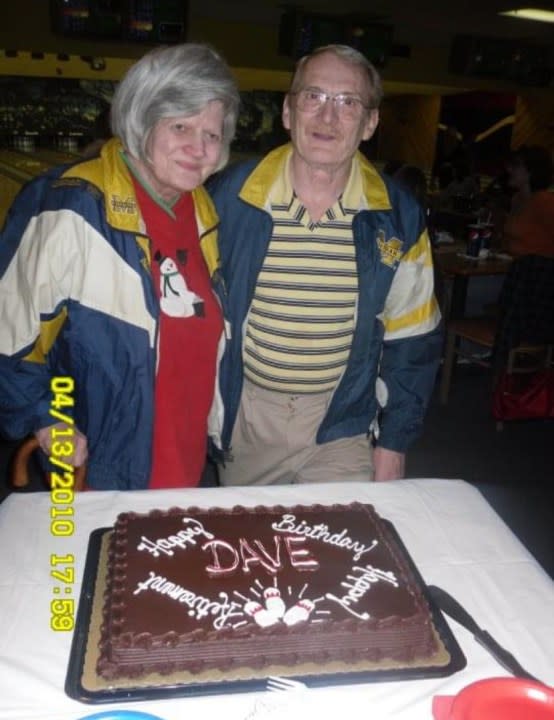
Reports in Probate Court tracked her childhood: The puppy she got for Christmas, the visits to the cemetery, the swing set for her birthday, a girl who knew her numbers by the time she was 3, grandparents who loved her.
She didn’t feel close to her grandfather when she was little.
“I think my grandpa kind of thought I looked a lot like my mom and kind of like tried to occupy his mind not on that,” Courteney Swartz said.
But they grew closer as she grew up. He became dad.
“He ended up being my best friend,” she said.
She was in first grade when Pops and Grandma Augie first told her about her mom.
“They sat me down on the bed and they told me, ‘We’ve got to talk to you about your mom, if you want to know,’ and I said, ‘Well, yeah I want to know.'” she said. “They told me that a bad man hurt my mom and that she was up in heaven.”
It was about as much as a first-grader could handle.
Then, in the fourth grade, they sat her down again.
“They actually told me that my mom was murdered, somebody entered the apartment and beat her really bad. She had just had like a root canal done and that is the side that she was mostly beaten on. Then they slit her neck from ear to ear,” she said. “I stayed home from school that day. I just took it in, and I just tried to live like a normal kid.”

She was 16 when her pops sat her down with a box of police reports and newspaper stories on the murder.
“I feel like, I want to know everything. Like that’s my mom. I want to know everything, so I read it. I guess I just wanted to feel like some closure to her. But I read it. And it’s very awful,” she said.
Courteney Swartz had her first child when she was 19, living scared, she said, in her first apartment on her own in Constantine, thinking about her mom.
“All I could think about is, ‘Is this going to happen to me, too?’ and I used to sleep with like knives in my drawer, by my bed,” she said. “I still do.”
She, like most in town, feared detectives would never solve her mom’s murder, a jumble of 10,000 yellowing pages of police reports in boxes. Task force after task force getting nowhere.
“After so long and so many stories, and like there would be leads, ‘Oh, we got a lead,’ then nothing else again. That went on for a long time,” she said.
Middleton, the prosecutor, occasionally locked himself in his office, poring over reports.
“I kept thinking, ‘It’s in here, I’m just not seeing it,'” he said. “It’s in here, and it was, and I didn’t see it.”
Through all of this, police kept coming back to Troy Schulthies, the ex-boyfriend who loved Metallica and went by Harley, even calling him a viable person of interest years later.
In 2012, members of a new cold case task force sat down with the original detective, Kenny Baker, who was fighting cancer.
“I’ve got two (tumors) in each lung and one up in my chest,” Baker told the detectives. “As long as they keep shrinking, that’s all I care about.”
Baker told them that his partner in the original investigation was certain that Schulthies was the killer.
“He was sure Troy did it, but the fingerprints and footprints weren’t Troy’s so that means there had to be a second party that probably came back during the day to help clean up and turn things around to make it look different,” Baker said.
Police reports show detectives had heard rumors that Schulthies got help from his father.
Schulthies’ father died before detectives could check his prints. The funeral home director refused to turn them over without a warrant.
“We never got those fingerprints or footprints,” said Middleton, the former prosecutor. “There was no evidence that Mr. Schulthies had helped Troy.”
Schulthies sued police in federal court, claiming they had ruined his reputation, but a judge tossed the suit.
More than 20 years after the murder, in an interview room at Three Rivers Police Department, the new detectives sat down with the cop who was there from the start, spitballing, speculating, testing his memory. The new detectives videotaped the interview.
“My memory’s pretty good when it comes to this because I put a lot of time in it,” Baker told them.
They asked for his theories.
“It might be all wet, but,” Baker said.
“That’s why you’re here, to give us other avenues to look at that we never thought of,” one of the cold case detectives responded.
And, they asked, what about all the evidence that was nowhere to be found? Crime scene video, videotapes of interviews and polygraph tests, the bloody shower curtains, video from Cathy’s funeral, a 35 mm camera seized from Cathy’s bedroom.
It’s tough to solve a case without all the evidence.
Baker recalled a state police detective taking the police reports from Three Rivers.
“Then one day when he was bringing the records back they fell out of his truck and they got all mixed up, all the fingerprints,” Baker said. “But we got them all back together, got them in the box.”

And, while the new detectives still had that unknown fingerprint left in blood on the phone, and that bloody footprint, what about all the other prints taken from the rest of the apartment?
They were all gone.
“If there was a print, I lifted it,” Baker told them. “So, where are all those things at?”
“I don’t know,” one of the cold case detectives answered.
“All I know is this, someplace there’s a sh–pot full of prints that were taken, and they’re all marked where they came from,” Baker said.
The new detectives also revealed what they saw as new evidence.
“What we recently just discovered is, about six months ago, that there was a blood stain on that same telephone that did not belong to the victim, did not belong to Michael Warner, did not belong to Troy Schulthies, that did not belong to Mike Howard. The profile came back to a male. It’s entered in CODIS at this point in time as of two months ago, but we have not got a hit on it yet,” a detective said.
Police hoped that CODIS, the Combined DNA Index System, would match one of the thousands of DNA profiles from known criminals and other crime scenes across the country.
“The only issue we have at this point in time is that the fingerprint in AFIS (Automated Fingerprint Identification System) and the blood stain in CODIS have not hooked up,” one of the new detectives said. “So, our fear is that the blood is going to come back to one person, the fingerprint’s going to come back to another, or that person has never been arrested or anything else, and his prints have never been in CODIS, or they’re dead.”
“That was the thing that was probably the most frustrating for anyone involved working the case, you know?” said Laninga, the original crime scene technician. “We knew we had the fingerprint and footprint and later as DNA developed, DNA. But originally out of the gate, we knew we had the killer’s fingerprint and footprint.”
There’s no way, detectives thought, that this could be a one-and-done. The killer had to have left his fingerprints or DNA at some other crime scene, before or after, or would eventually.
“I remember looking at the (crime scene) pictures, thinking this isn’t the only time this person’s going to do this,” Middleton, the former prosecutor, said.
The original detective was certain the killer was still alive.
“Now you’ve got DNA, you’ve got a finger and you’ve got a footprint. All you need is the person to match,” he told the new cold case detectives.
Students from Western Michigan University’s Cold Case Program organized and scanned the 10,000 pages of documents, making it easier for new detectives to search. The students worked up timelines of the days leading up to the murder.
Finally, in May 2022, the Michigan State Police crime lab DNA director in Grand Rapids, Sgt. Joel Schultze, suggested one last chance to solve the decades-old case.
The state police sent a frozen DNA sample of that bloody fingerprint from Cathy’s pink phone to a fledgling forensics genome sequencing lab known as Othram in suburban Houston, Texas.
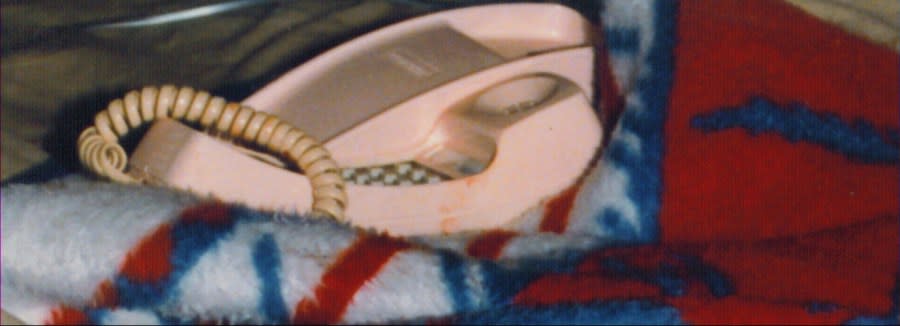
“The kinds of cases we work are the cases where there is no hope left, there’s nothing else that can be done,” said Othram’s Chief Development Officer Kristen Mittelman.
Othram is the only lab in the world created just to identify victims and solve crimes. Since opening in 2019, it has turned over 1,200 investigative leads to police across the country.
Othram developed technology that allows it to build profiles from the tiniest amounts of even the most degraded DNA.
“You have a body that’s been burnt after somebody was murdered, thrown at the bottom of a lake, trace amounts of perpetrator DNA, crime scenes from 1881,” Mittelman said. “I mean, you name it, we’ve seen it.”
The standard CODIS test looks at 20 DNA markers, enough to match with a known suspect or find a close relative.
‘Game-changer’: Genealogy helps police crack cold cases
But Othram’s scientists build DNA profiles based on hundreds of thousands of markers.
“It’s like if you had a bad camera and you were taking really foggy pictures,” she said. “We’re able to make them more clear by using our method and you’re able to get a lot more markers.”
Othram enters the detailed DNA profile into public genealogical databases to find distant relatives.
“If you have a small number of markers, you’re only going to get very close relationships,” Mittelman said. “If you have a large number of markers, which is what we have built, then you are getting really distant relatives, like sixth cousins, fifth cousins, fourth cousins, relatives you do not know whatsoever.”
The team narrows the search through birth, marriage and death records to finish building a family tree.
By January 2023, Othram had narrowed it down: Swartz’s killer was one of four sons of John and Judith Waters, who had raised their family just north of Three Rivers.
“It’s the most incredible feeling in the world to know that you can help bring answers to someone’s family that has been waiting for them for so long,” Mittelman said.
But which brother?
PART 4: THE MATCH
DNA from the youngest of the Waters’ sons was already in the system and didn’t match. Two other brothers who lived in Southwest Michigan agreed to DNA tests.
One of those brothers, Sonne Waters, met with the latest of the detectives working the case, Three Rivers Sgt. Sam Smallcombe, who mentioned nothing about the newest DNA work, how the list of killers had been narrowed down to him and his brothers. The meeting at the Three Rivers Police Department was videotaped.
“Literally, I have a list of 2,000 names from that time period of people that were living in the area, and your name just happened to be on the list for whatever reason. Nobody’s ever contacted you?” Smallcombe asked Sonne Waters.
“No, this is the first I’ve ever heard from anybody,” he responded.
There’s a reason, Sonne Waters volunteered, that his brother Robert left Three Rivers and moved to South Carolina.
“He got in a little trouble here at home, they put him in a juvenile home for a little while, but he did his time there, done good and got out and married a really nice lady, and she said, ‘I’m getting you out of this state.’ She said, ‘You’re not going to hang around here because it’s not good for you,'” he said.
It’s not clear what trouble he got into. The juvenile records aren’t available.
“He started his own plumbing business out there and he’s been doing it ever since,” his brother told the detective.
Sonne Waters agreed to give a DNA sample, a swab from inside his mouth.
“I’d love to help any way I can, you know,” he said. “Get justice done. It’s a sad thing.”
Soon, they were down to one brother: Robert Waters. He was the childhood friend of Swartz’s fiancé. When they were young, they’d spend the night at each other’s homes. They built forts together.
Just a month before the murder, Waters and his girlfriend had visited Swartz and Mike Warner’s apartment.
But he had moved away to Phoenix, and police never checked his prints.
“Of the thousands of people that they took our handprints and fingerprints and footprints, why didn’t they?” Swartz’s friend, Jennifer Outman, asked. “Why didn’t they?
“That’s a big mess up, a big issue,” she said.
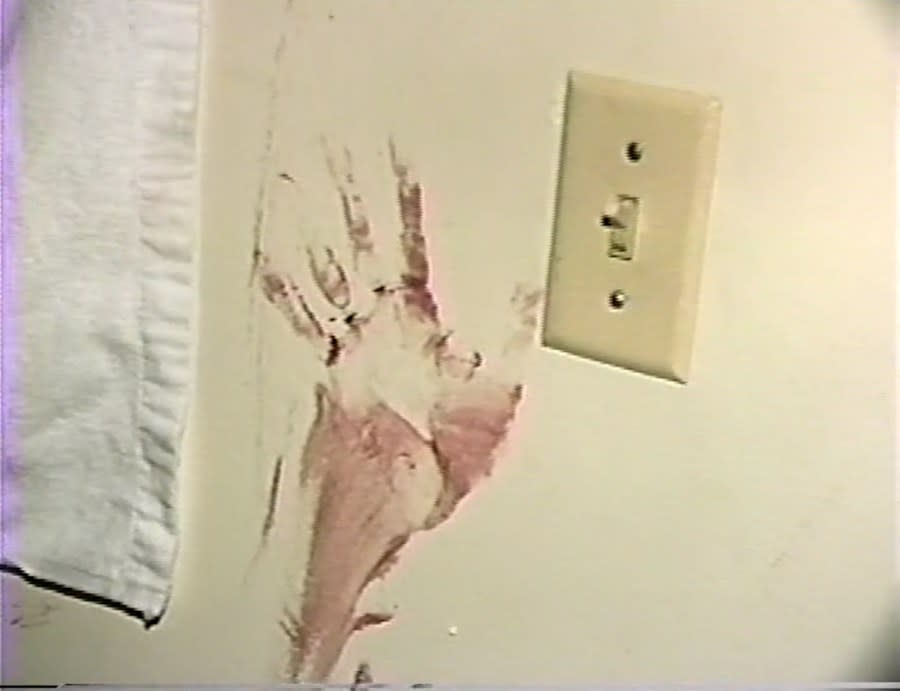
“He was one line in 10,000 pages of police reports,” Middleton, the former prosecutor, recalled. “But he was in there. I always felt the guy who did it is in here somewhere, and I’m going to find it, and I didn’t.
“Somebody did finally,” he said.
It was 7:40 in the morning on April 30, a Sunday, in Beaufort, South Carolina. Two detectives, Smallcombe from Three Rivers Police and Michigan State Police Detective Todd Petersen knocked on Robert Waters’ door.
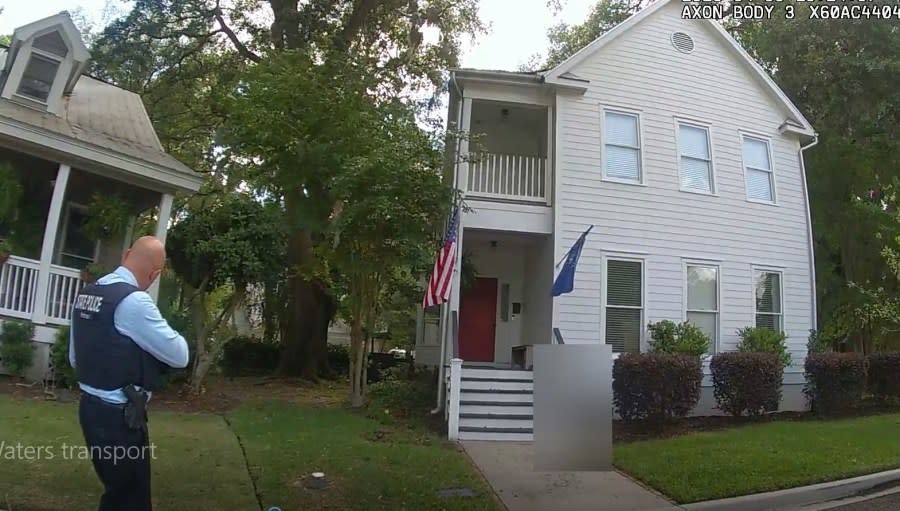
“So we were just wondering, I know it’s just out of the blue. We just stopped by here, but we had both talked to your brothers,” the state police detective said. “Not sure if they told you we had talked to them back in February.”
“Right,” Waters said.
“So I’m helping Sam and we reopened this case from Three Rivers from way back in the day. Going back through and getting interviews,” the detective said. “So we were wondering if you wouldn’t, if you had time to come down to the PD and talk to us down there?”
“Where do I have to go?” Waters asked.
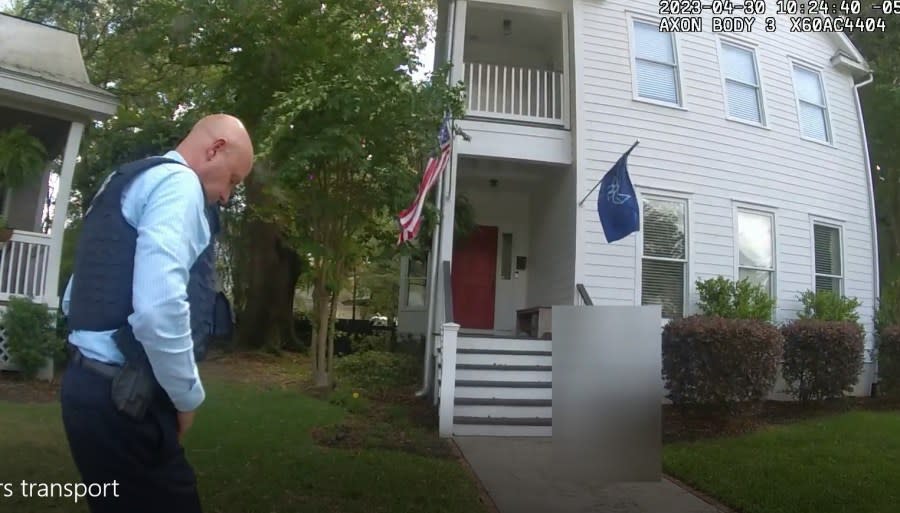
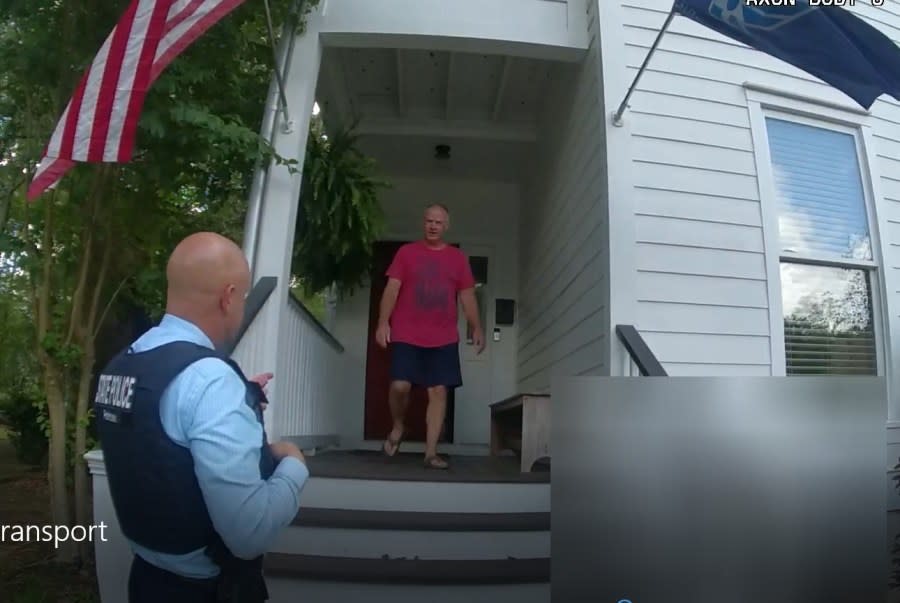
Waters, now 54, was a successful plumber, married with two children and living in a half-million dollar home.
Police were not letting on that he was now their one and only suspect.
“We’re kind of making a circle around, trying to clean up all the people who aren’t in Michigan,” the state police detective said. “Trying to clear everybody and say, ‘Hey, we’ve talked to them.’ It’s just kind of how we do stuff. I know it’s kind of a shocker to have us just, boom, show up.”
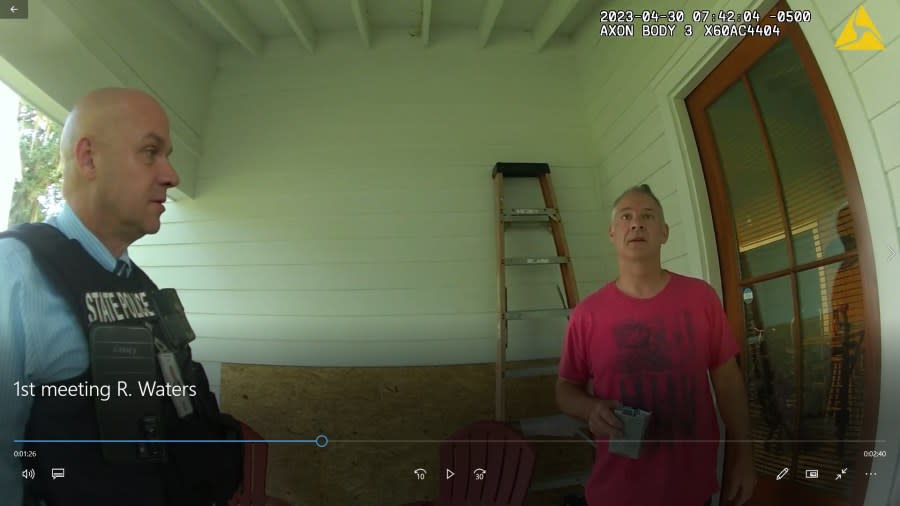
But Waters didn’t show up at the Beaufort Police Department as promised, leading to a tape-recorded phone call to him from the state police detective.
“I’m just getting ready to head up that way, and, basically, you want to question me about what again?” Waters asked.
“It’s about — you may not even remember — it’s back in 1988 there was a homicide of a girl in Three Rivers, Michigan, where you used to live, or near,” the state police detective responded.
“OK,” Waters said.
“Yup,” the detective said. “So we’ve opened that case back up.”
“You have to kind start in the outskirts and work your way back in and anybody whose name was mentioned in the report at all to begin with, we just want to get you know, a statement. We know you’re not the suspect in it, but with that being said,” the detective said.
“When exactly did that happen?” Waters asked.
Back in 1988, he was told.
“Because I do know that we were in Arizona because my daughter was born down there in Phoenix … in January ’89,” Waters said.
A short time after the phone call, police got a call from Waters’ attorney.
“I’m just going to be upfront with you about what we have,” the state police detective told the attorney. “We have search warrants for his DNA and his fingerprints. That’s a nice little neighborhood. I really don’t want to go in kicking doors.
“I’ll also tell you that there’s an unmarked unit with an eye on the place and has since this morning, since we first made eye contact.”
“So,” the attorney said, “you’re telling me it’s too late for him to run, too, right?”
“Yeah, that would be a mistake,” the detective answered.
“He’s got a very successful plumbing business and stuff,” the attorney said.
“He’s got a lot to lose down here, don’t want him to screw it up now,” the detective responded.
By mid-morning, police were back at Waters’ home. They drove him down to the Beaufort Police Department.
By 11:40 a.m. that Sunday, police in Beaufort were busy fingerprinting a man who had never given them any trouble. The entire exchange was captured on a body camera.
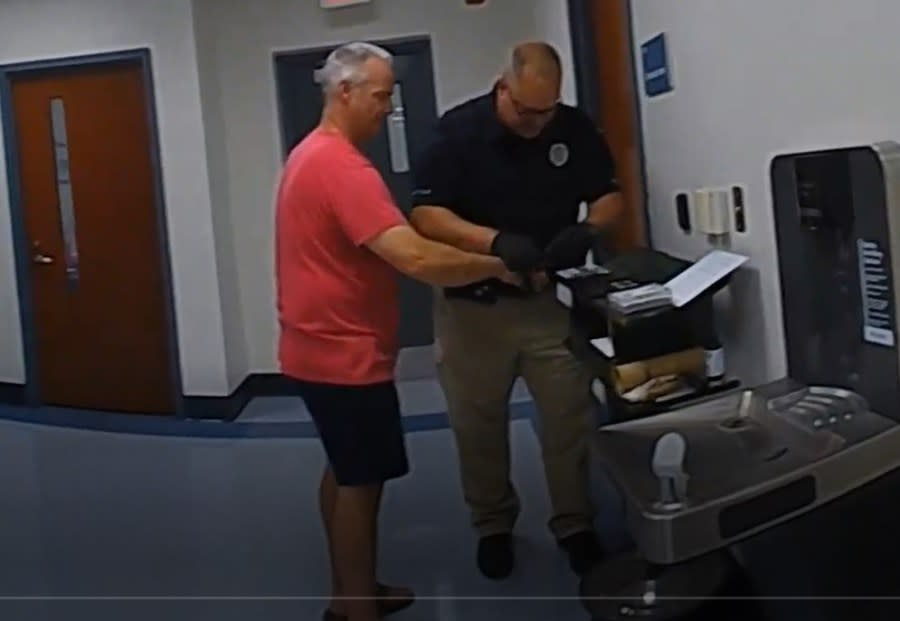
Waters told them he’d been a plumber for 20 years.
“At one point we had like six trucks, but that was way back when the economy crashed,” he told detectives. “Well, my wife was pregnant so my son’s 19, that was like 19 years ago that we downsized. I’ve been on my own ever since. I do service, repair, remodels. The stuff that I can handle. I mean, because I broke my back back in 2018, so I’m a limited guy, you know.”
If he was worried, it wasn’t showing. Not once did he complain during his seven-plus hours at the police station.
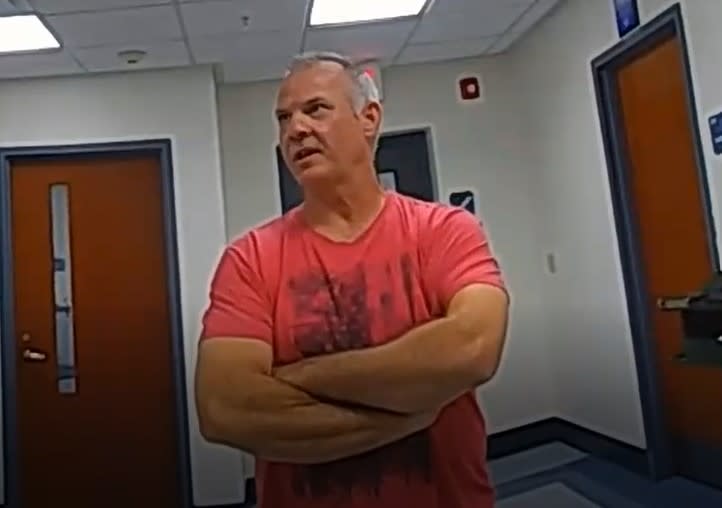
It was seven hours of small talk — Detective Petersen is a master at small talk — about the weather, the cost of coffee K-cups, LASIK eye surgery, the merits of plastic plumbing pipes, Michigan’s booming marijuana trade.
“I can’t believe they let it get out of hand like that up there,” Waters said.
What Waters didn’t know was that the state police back at a lab in Michigan were checking his prints against the print left on Cathy’s pink telephone.
Three times they had to fingerprint him, to make sure they got it right, to make sure they rolled the fingertips.
More small talk, this time about his homeowners association.
“We’ve got everything we need pretty much,” Waters said. “Tennis court, walking trails, community dock.”
Life’s been good.
Then, it’s on to a DNA swab and taking his footprints.
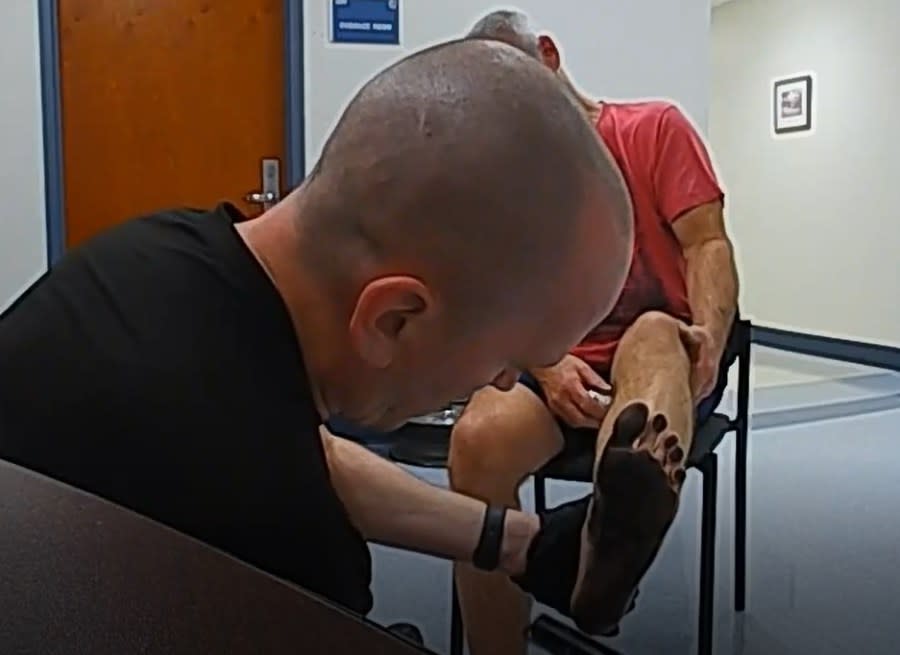
Over the years, police had taken more than 1,000 footprints in this case, hoping one would match the print left in blood in Cathy’s bathroom.
After 35 years, they expected this would be the last.
By 5:45 p.m., 10 hours after police showed up at Waters’ door, the Three Rivers detective entered the room at the police station where their now-only suspect was waiting.
“We did submit the prints that we took from you earlier,” Detective Smallcombe said. “It did match to the one at the crime scene. So our prosecutor has authorized a warrant for your arrest.”
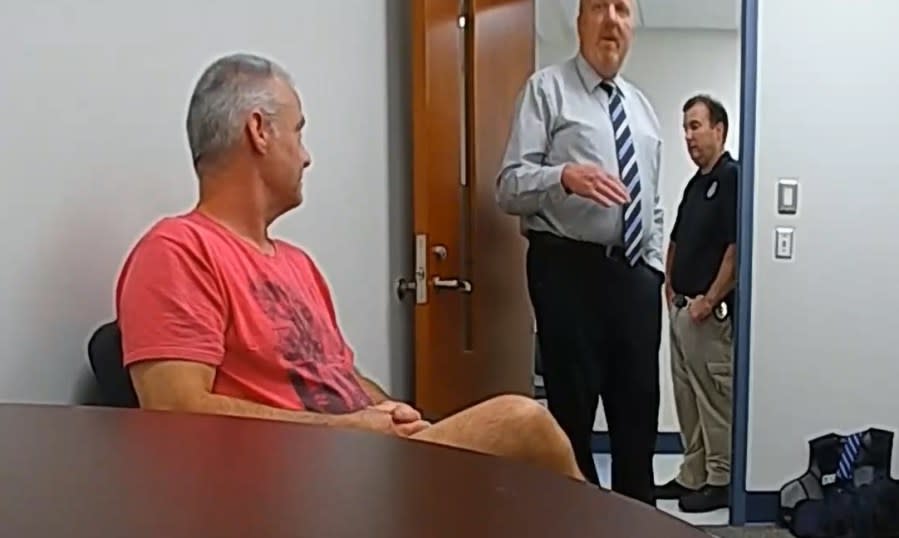
Waters nodded.
“And the judge signed it, so at this time, you’re under arrest for the murder of Cathy Swartz. OK?” Smallcombe said.
“OK,” Waters answered.
He’s placed in handcuffs.
There is no more small talk.
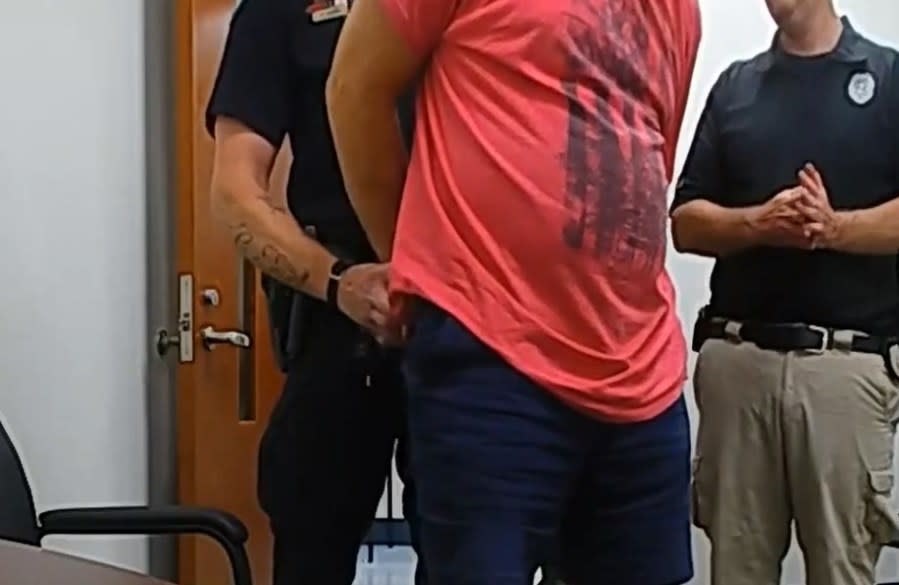
His footprint also was a match, and so was his DNA to the blood left on Cathy’s phone.
“Nobody ever let this case go,” said Laninga, the retired crime scene tech. “They kept working on it and working on it, through different generations, different crews of people.”
But it wasn’t in time for Courteney Swartz’s Pops and Grandma Augie, or for the original detectives including Kenny Baker, who all died before it was solved.

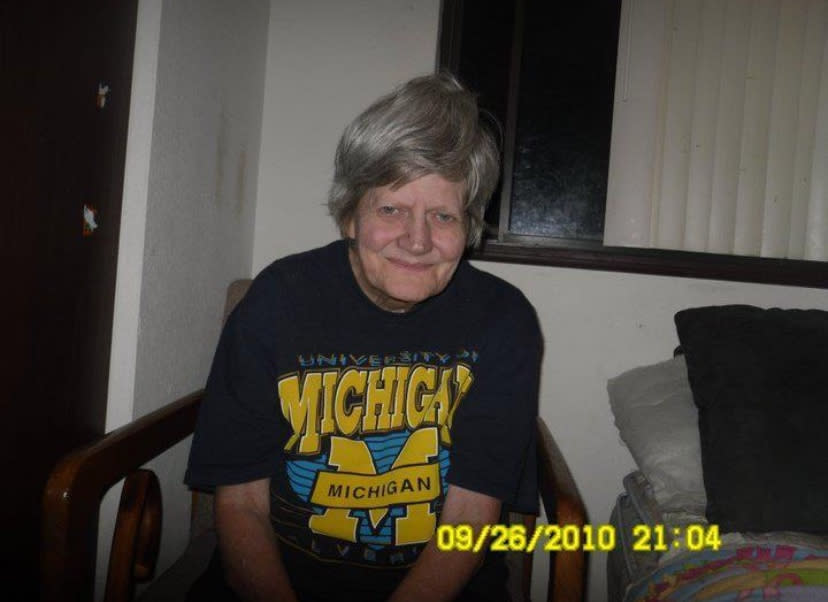
Arrest made in 1988 murder of young Three Rivers mother
Robert Waters’ daughter immediately questioned her father’s arrest in a Facebook post.
She has not responded to Target 8’s requests for an interview.
“You can understand,” the retired crime scene tech said. “Her life was just shattered also. I mean, how do you wrap your head around that? How do you deal with that? You would have to be hoping there was some mistake or whatever. ‘This can’t be my dad.'”
But, he said, the DNA and the prints don’t lie.
“She’s in denial,” Swartz’s friend said. “It’s her dad. She had no clue; she probably never saw a mean side of him, or you know. I get it. I feel bad for his family. I really do. They’re absolutely victims. Absolutely. And that’s the thing, he murdered Cathy but that affected so many people.”
Police had called Swartz’s daughter on April 29 to tell her they had reopened the case.
“The next day is when they called and said they were down in South Carolina and they had Robert Waters in custody,” she said.

He was a man she’d never heard of, living 900 miles away in Beaufort, South Carolina, a city she’d never heard of.
“It kills me knowing that they just are down there, they were just down there living the best life that they could, and here I am trying to make sure that my kids never feel what I felt,” Courteney Swartz said.
As she waited for St. Joseph County sheriff’s deputies to return Waters to Michigan to face charges, she prepared herself to see him in court.
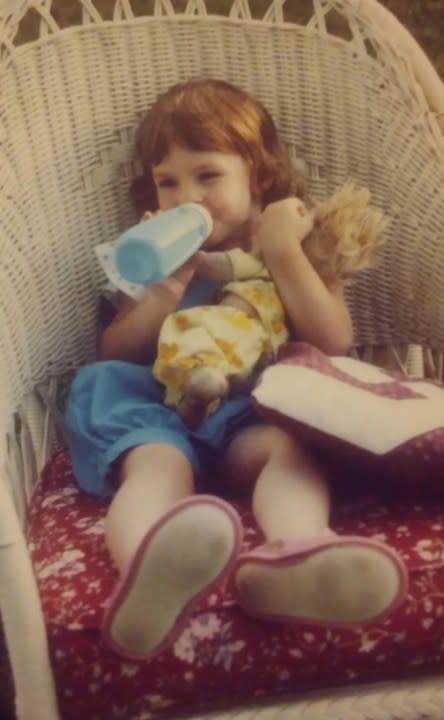
“He didn’t have to look at me or anything; he didn’t have to say anything. All I wanted was for him to feel my presence in that room. Like I’m the baby, here I am 35 years later. That is all I wanted,” she said.
Cathy Swartz’s best friend also prepared herself for that day in court.
“Absolutely, I’d have been there every day. No doubt, yeah. I wanted justice. I wanted him to pay. For Cathy, Courteney, her brother Dave, all of us who are left over, all of her friends. Nobody should be allowed to get away with that,” she said.
Murdered mom’s daughter: ‘I’m the baby; here I am 35 years later’
Just five days and eight hours after his arrest, Waters hanged himself with a sheet in the Beaufort County Detention Center.
“I was pissed. I was very angry,” Cathy Swartz’s best friend said. “What were they doing down there that he wasn’t being watched? It just seems to me if somebody gets caught after that many years that it would be an automatic thought of whoever’s holding him, ‘Hey, we better watch this guy.'”
Reports show Waters was being held in general population, in a cell by himself, not on suicide watch. Guards found Bible-based pamphlets on a table in Waters’ cell, about creation and forgiveness.
“He’s a coward,” Swartz’s daughter Courteney Swartz said. “I feel there might be more to this story and him just taking his own life was just the easiest way for him to not have to deal with anything.”
“One of my friends was telling me, ‘You know, like he is where he needs to be now,’ talking about hell because he killed himself, and I said, ‘I don’t feel like he deserves to be in heaven or hell. I feel like he is in limbo right where I am. Like I’ve been in limbo my whole life, like I didn’t have a mom, I didn’t have a dad, I did have my grandparents, but that’s not the same,'” she said. “I feel like I’m more in limbo now than I was before.”
Cathy Swartz’s fiancé never suspected his childhood friend.
Cold case murder suspect who died in jail had writings on forgiveness
“I never thought of him,” Mike Warner said. “He visited one time, we were friends when we were younger, you know? Now, it makes you wonder, how many others could there be, you know?”
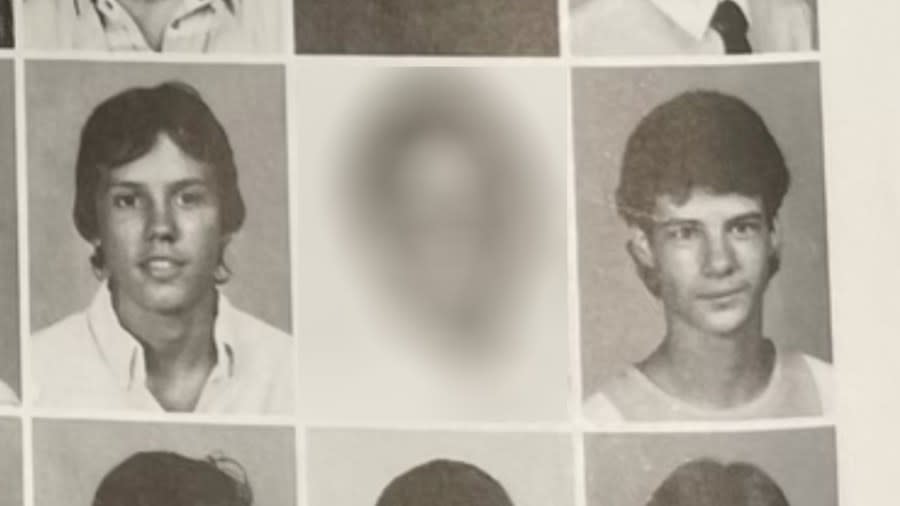
What about those two murders in northern Indiana? Like Cathy Swartz, young women living alone, throats cut, all three killed on Fridays.
Swartz’s daughter wonders if Waters killed others.
“Especially how he did it,” she said. “That’s not just something that a person goes and does. I have asked myself that.”
The scientists at Othram, the DNA lab, say it’s too early to rule out Waters for other crimes.
“CODIS now has his DNA, so if another crime scene does get worked, another cold case out there pops up from another state or the same state and he was involved, it will immediately hit and our technology won’t even be necessary,” said Othram’s Chief Development Officer Kristen Mittelton.
So here we are, 35 years later.
Troy Schulthies, the long-suspected ex-boyfriend known as Harley, quit school and left his hometown to escape the whispers and finger-pointing. He is back in Three Rivers, living in his mom’s basement and can’t hold a job.
He wouldn’t go on camera, but his mom did.
“It was devastating,” Pearl Schulthies said. “Any way you look at it. Everybody’s talking behind your back.”
She said it turned her son into a “hermit.”
“He just stayed to himself. How can you explain it? It ruined him. Flat ruined him. Period. You can see what his health is. No doubt in my mind. He has health issues,” she said.
She couldn’t believe it when she heard the news about Waters’ arrest.
“Somebody told me. I ran down and told Troy as fast as I could run. We’ve lived with it for 35 years, not only him. We have, too,” she said. “It was smiles, you know. Finally, somebody, after this many years, they found someone who did it.”
Her son’s name was finally cleared for good.
“For good, yes. But it’s a day late. It doesn’t improve his health,” she said.
Swartz’s best friend is left to wonder, what would have happened if the worst hadn’t happened?
Cathy Swartz would be 54, a grandmother.

Sign up for the News 8 weekly recap newsletter
“I think about that all the time. I do. I think about, OK, if that wouldn’t have happened we would have continued our friendship; they would have gotten married; I’m sure she would have had more children. I believe she’d still be living here. She was a small-town girl, like me,” she said.
As for Warner, Cathy Swartz’s fiancé, he’d planned to spend the rest of his life with her and help raise her daughter.
“It turned me into an alcoholic is what it did,” he said. “Pretty much, yeah, for a while.”
He lives with his mother just outside of town. He can’t hold a job. Most days, he rides his bike, pulling his dog Buddy in a wagon and picks up bottles and cans.
For a while, he would leave a rose on Cathy’s tombstone.
“There was always flowers and like little decorations that we didn’t put out there, like me and my grandpa and grandma didn’t put out there, so they had to have been from Mike,” Cathy Swartz’s daughter recalled.
Courteney was 19 when she last visited Mike Warner’s mom, Grandma Glory. The man who had planned to raise her showed up.
“He came to the house and he walked in and he saw me and he walked out, and that was really the last time that I talked to him. And Grandma Glory told me it’s because I look so much like my mom that he couldn’t handle seeing me because all he thought about was her,” she said.
She has since seen him on his bike around town.
“I told my kids like, I’m like, ‘Oh my god that’s the guy that my mom was going to marry, and like he was going to adopt me.’ It just didn’t happen that way,” she said.
“Yeah,” Cathy Swartz’s fiancé agreed. “It just didn’t work out that way, I guess.”
TIMELINE
March 27, 1988: Cathy Swartz gives birth to daughter, Courteney.
September 1988: Cathy Swartz and Robert Warner get engaged.
Dec. 2, 1988: Cathy Swartz, 19, murdered in her apartment while 9-month-old daughter was in her crib in another room.
Dec. 5, 1988: Police arrest ex-boyfriend, Troy Schulthies, for murder.
Dec. 6, 1988: Paternity test identifies Michael Howard as the father of Courteney. Prints and an alibi rule him out as a suspect.
Dec. 14, 1988: Schulthies is released from jail, charges dropped, after prints don’t match. Remains a “viable” person of interest.
January 1989: Police release composite drawing of woman they believe is either the killer or an accomplice. Nothing comes of it.
August 1989: A woman is murdered in a similar manner in Portage City, Indiana.
October 1989: A woman is murdered in a similar manner in Warren, Indiana.
May 2011: Report still lists ex-boyfriend, Troy Schulthies, as viable person of interest.
March 2012: DNA from crime scene sent to CODIS. No matches.
May 2022: MSP reaches out to Three Rivers about sending DNA to Othram for new forensic genetic genealogy testing.
Jan. 17, 2023: Othram notifies police it had narrowed down the suspect list to one of four brothers.
April 30, 2023: Robert Waters, 53, one of those four brothers, is arrested after prints and DNA match. He was 19 at the time of the murder.
May 6, 2023: Waters dies by hanging himself in Beaufort County Detention Center.
For the latest news, weather, sports, and streaming video, head to WOODTV.com.

